Sources
- Greg Hoffman, The Art of World Team Tennis, San Francisco Book Company, 1977 ISBN 0-913374-65-2
- World Team Tennis, Official site
The multi-colored no-line tennis court is a variant design for a tennis court introduced by World TeamTennis (WTT) during its early years.
The different areas of the no-line tennis court are defined by colors instead of white lines. White lines on a standard tennis court are painted onto a single or two-tone, colored background, as required by the rules of the United States Tennis Association (USTA) and the International Tennis Federation (ITF).
The original multi-colored, no-line tennis court has eleven separate colored areas with no segregating lines. As a functional, no-line tennis court design it was issued a USPTO utility patent #4,045,022 in 1977 to its inventors, Geoffrey Grant, an avid and successful senior tennis competitor, and Robert Nicks, an engineer. These two inventors also developed, tested and patented (USPTO patent. # 3,982,759 the original tennis electronic line judge used by the men's World Championship Tennis and women's tennis tours in 1974–75.
Distinctively, the no-line, multi-colored tennis court deviates from both the USTA and the ITF rules because the court‘s playing zones are separated by color instead of lines. Specifically, the court lacks a line dividing the service courts that is two inches wide and twenty-one feet long, and within the rules of tennis, this line is considered to be a part of both service zones. During play, a tennis ball served that hits the shared line is playable from either side service positions. In the absence of the line the size of both service areas deviates from the rules because each court is one inch (2.5 centimeters) narrower than specified by the USTA and the ITF.
The multi-colored court used by the Advanta WTT sponsored league in 2008–09 is a compromise in that it has both white lines and the colored areas that satisfies both the rules of the tennis organizations and media appeal.
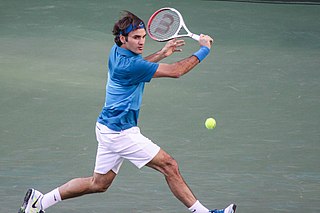
Tennis is a racket sport that can be played individually against a single opponent (singles) or between two teams of two players each (doubles). Each player uses a tennis racket that is strung with cord to strike a hollow rubber ball covered with felt over or around a net and into the opponent's court. The object of the game is to maneuver the ball in such a way that the opponent is not able to play a valid return. The player who is unable to return the ball will not gain a point, while the opposite player will.

A tennis court is the venue where the sport of tennis is played. It is a firm rectangular surface with a low net stretched across the centre. The same surface can be used to play both doubles and singles matches. A variety of surfaces can be used to create a tennis court, each with its own characteristics which affect the playing style of the game.

Shuffleboard, more precisely deck shuffleboard, and also known as floor shuffleboard, is a game in which players use cues to push weighted discs, sending them gliding down a narrow court, with the purpose of having them come to rest within a marked scoring area. As a more generic term, it refers to the family of shuffleboard-variant games as a whole.
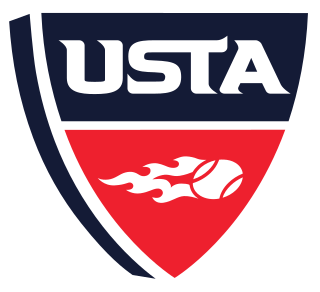
The United States Tennis Association (USTA) is the national governing body for tennis in the United States. A not-for-profit organization with more than 700,000 members, it invests 100% of its proceeds to promote and develop the growth of tennis, from the grass-roots to the professional levels. The association was created to standardize rules and regulations and to promote and develop the growth of tennis in the United States.

World TeamTennis (WTT) is a mixed-gender professional tennis league played with a team format in the United States, which was founded in 1973.
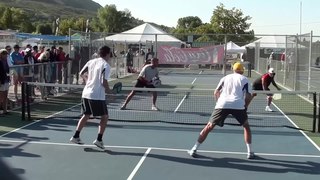
Pickleball is a paddleball sport that combines elements of tennis, badminton, and table tennis. Two or four players use solid paddles made of wood or composite materials to hit a perforated polymer ball, with 26-40 round holes, over a net. The sport shares features of other racquet sports: the dimensions and layout of a badminton court, and a net and rules somewhat similar to tennis, with several modifications. Pickleball was invented in the mid 1960s as a children's backyard game.
A point in tennis is the smallest subdivision of the match, the completion of which changes the score. A point can consist of a double fault by the server, in which case it is won by the receiver; otherwise, it begins with a legal serve by one side's server to the receiver on the other, and continues until one side fails to make a legal return to the other, losing the point. Four points win a game, counted as 15, 30, 40. A game must be won by at least two points.
This page is a glossary of tennis terminology.

Rosemary "Rosie" Casals is a former American professional tennis player.

Ilana Sheryl Kloss is a former professional tennis player, tennis coach, and commissioner of World TeamTennis, since 2001. She was the World's No. 1 ranked doubles player in 1976, World No. 19 in singles in 1979.
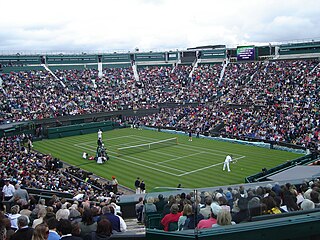
The game that most people call tennis is the direct descendant of what is now known as real tennis or royal tennis. Most rules of the game commonly known as tennis derive from it. It is reasonable to see both sports as variations of the same game. Most historians believe that tennis originated in the monastic cloisters in northern France in the 12th century, but the ball was then struck with the palm of the hand; hence, the name jeu de paume. It was not until the 16th century that rackets came into use, and the game began to be called "tennis." It was popular in England and France, and Henry VIII of England was a big fan of the game, now referred to as real tennis.

In tennis, an official is a person who ensures that a match or tournament is conducted according to the International Tennis Federation Rules of Tennis and other competition regulations.
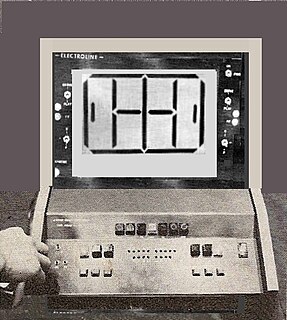
An electronic line judge is a device used in tennis to automatically detect where a ball has landed on the court. Attempts to revolutionize tennis officiating and the judging of calls in the sport began in the early 1970s and has resulted in the design, development and prototyping of several computerized, electronic line-judge devices. The methods have been based upon the use of pressure sensors, sensors to detect magnetized or electrically conductive tennis balls, infrared laser beams, and most recently video cameras.
A patent application or patent may contain drawings, also called patent drawings, illustrating the invention, some of its embodiments, or the prior art. The drawings may be required by the law to be in a particular form, and the requirements may vary depending on the jurisdiction.
The following outline is provided as an overview of and topical guide to tennis:
Peanut Louie Harper is a retired American tennis player, born in San Francisco, California to Ron and Alice Louie. She was a top-ranked junior tennis player and professional tennis player on the WTA tour. She reached a career high singles ranking of 19 in the world in 1985 and doubles ranking of 31 in the world in 1992. She is currently the co-founder and program director of Harper for Kids, a youth character development program.

Taylor Townsend is an American professional tennis player. She reached a career-best WTA ranking of No. 61 in July 2018.

Asia Muhammad is an American tennis player who turned professional in 2007.
Ben Press was an American tennis player, coach, and writer, known for his involvement in World Team Tennis, his connection with the Hotel del Coronado, and as teacher of tennis standouts such as Maureen Connolly and Karen Hantze Susman.

The New Orleans Sun Belt Nets were a charter franchise of World Team Tennis (WTT). The team first played as the Cleveland Nets in 1974, and was known as the Cleveland-Pittsburgh Nets in 1977, when it played roughly half of its home matches in each city. The Nets moved to New Orleans for the 1978 season. Following the 1978 season, the Nets announced that the team would fold. The Nets played all five seasons in WTT from the league's inception in 1974, until its suspension of operations after the 1978 season. The team had losing records in each of its five seasons.